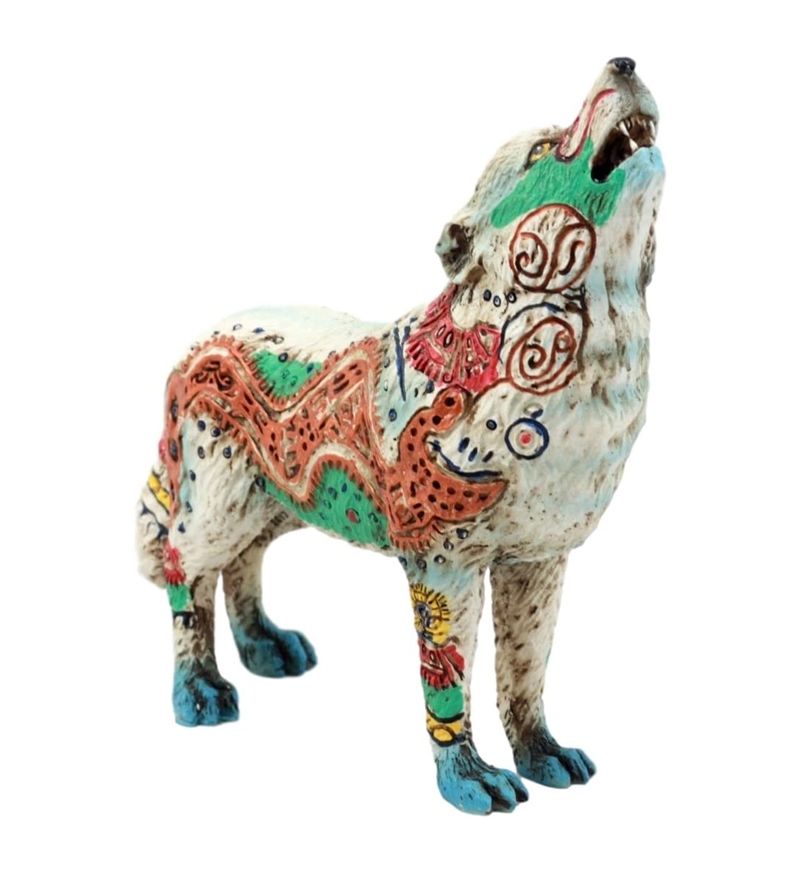Ancient Aztec Sun Stone “Xiuhpohualli and Tonalpohualli” Calendar Statue
This Ancient Aztec Solar Calendar Statue is made of designer composite resin, hand painted and polished, and the high detail and professional finish makes this piece an amazing show piece. The Aztec Calendar or Mexica Calendar is the calendrical system used by the Aztecs as well as other Pre-Columbian peoples of central Mexico. It is one of the Mesoamerican calendars, sharing the basic structure of calendars from throughout ancient Mesoamerica. The Aztec Sun Stone, also called the Calendar Stone, is on display at the National Museum of Anthropology in Mexico City. The calendar consists of a 365-day calendar cycle called Xiuhpōhualli “year count” and a 260-day ritual cycle called Tōnalpōhualli “day count“. These 2 cycles together form a 52-year “century“, sometimes called the “calendar round“. The xiuhpōhualli is considered to be the agricultural calendar, since it is based on the sun, and the tōnalpōhualli is considered to be the sacred calendar.
The tōnalpōhualli consists of a cycle of 260 days, each day signified by a combination of a number from 1 to 13, and one of the twenty day signs. With each new day, both the number and day sign would be incremented: 1 Crocodile is followed by 2 Wind, 3 House, 4 Lizard, and so 4th up to 13 Reed, after which the cycle of numbers would restart (though the 20 day signs had not yet been exhausted) resulting in 1 Jaguar, 2 Eagle, and so on, as the days immediately following 13 Reed. This cycle of number and day signs would continue similarly until the 20th week, which would start on 1 Rabbit, and end on 13 Flower. It would take a full 260 days (13×20) for the 2 cycles (of 20 day signs, and 13 numbers) to realign and repeat the sequence back on 1 Crocodile. The 260 days of the sacred calendar were grouped into 20 periods of 13 days each. Scholars usually refer to these 13-day “weeks” as trecenas, using a Spanish term derived from trece “thirteen“, just as the Spanish term docena “dozen” is derived from doce “twelve“.
Xiuhpōhualli is the Aztec year “xihuitl” count “pōhualli“. One year consists of 360 named days and 5 nameless “nēmontēmi“. These “extra” days are thought to be unlucky. The year was broken into 18 periods of 20 days each, sometimes compared to the Julian month. The Nahuatl word for moon is “metztli” but whatever name was used for these periods is unknown. Through Spanish usage, the 20-day period of the Aztec calendar has become commonly known as a veintena. Each 20-day period started on Cipactli “Crocodile” for which a festival was held. The dates are from early eyewitnesses, each wrote what they saw. Bernardino de Sahagún‘s date precedes the observations of Diego Durán by several decades and is believed to be more recent to the surrender. Both are shown to emphasize the fact that the beginning of the Native new year became non-uniform as a result of an absence of the unifying force of Tenochtitlan after the Mexica defeat. The Ancient Mexicans counted their years by means of 4 signs combined with 13 numbers, thus obtaining periods of 52 years, which are commonly known as Xiuhmolpilli, a popular but incorrect generic name. The most correct Nahuatl word for this cycle is Xiuhnelpilli.
For many centuries scholars had tried to reconstruct the Calendar. A widely accepted version was proposed by Professor Rafael Tena of the Instituto Nacional de Antropología e Historia, based on the studies of Sahagún and Alfonso Caso of the National Autonomous University of Mexico. His correlation argues that the first day of the Mexica year was February 13 of the old Julian calendar or February 23 of the current Gregorian calendar. Using the same count, it has been the date of the birth of Huitzilopochtli, the end of the year and a cycle or “Tie of the Years“, and the New Fire Ceremony, day-sign 1 Tecpatl of the year 2 Acatl, corresponding to the date February 22. Another correlation by Ruben Ochoa uses pre-Columbian sources to reconstruct the calendar, using a method that fixes the year count to the vernal equinox and placing the first day of the year on the first day after the equinox. Aztec Sun Stone Xiuhpohualli and Tonalpohualli Calendar Statue measures: 12.2 inches / 31 cm x 2.7 inches / 7 cm x 12.2 inches / 31 cm.
Ancient Aztec Solar Calendar Statue on Amazon.
Ancient Aztec Solar Calendar Statue on eBay.





You must be logged in to post a comment.